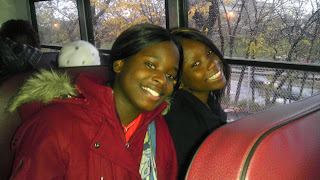
Our knitlab had a wonderful experience at SHoP (Southside Hub of Production) at 5638 S. Woodlawn. It was a place where we learned how to use new tools and help out with "The Red Thread Project." We learned how to use knitting looms, which are kind of like a special kind of knitting stencil. I say this because we learned how a man with no fingers could use this tool because you don't need the knitting sticks.
The website describes the project like this:
"The Red Thread Project is community art made by the community for the community. Hundreds of youths and adults knit and crochet hats; attach the hats to a ½ mile long knitted red thread; wear the hats in a simple performance / dance; exhibit the hats and, finally, donate the hats to local charities including those assisting cancer patients, foster children, the elderly and the homeless."
"The Red Thread Project is community art made by the community for the community. Hundreds of youths and adults knit and crochet hats; attach the hats to a ½ mile long knitted red thread; wear the hats in a simple performance / dance; exhibit the hats and, finally, donate the hats to local charities including those assisting cancer patients, foster children, the elderly and the homeless."
We also helped knitting the red i-cord that hold the hats together, we modeled the hats that were made, and talked a lot about the whole idea behind why all the hats are connected. Ms. Obermeyer talked about how she had cancer when she was only seven and the doctors told her she had a certain amount of months to live; and she talked about how everyone started helping her out by donating blood. So to sum it up, she believes everyone is connected in some type of way, and this is why all the hats are connected by the i-cords.
So on the behalf of our knitlab, I want to thank Ms. Obermeyer for letting us share these experiences with her. You can visit her web site at http://www.theredthreadproject.com/welcome.html
- Tequila Mckay
Epilogue:
Ms. Karen went to the culminating performance of The Red Thread Project this past Saturday at the Chicago Cultural Center. One of the hats our knitlab donated (the dog hat that Sierra made) was the first hat on the rope!
So on the behalf of our knitlab, I want to thank Ms. Obermeyer for letting us share these experiences with her. You can visit her web site at http://www.theredthreadproject.com/welcome.html
- Tequila Mckay
Epilogue:
Ms. Karen went to the culminating performance of The Red Thread Project this past Saturday at the Chicago Cultural Center. One of the hats our knitlab donated (the dog hat that Sierra made) was the first hat on the rope!

























